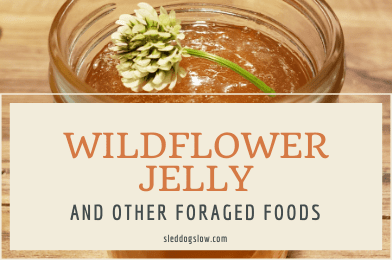High Tide Homestead participates in affiliate programs and may earn commissions from qualifying purchases on this post. See our Disclosure page for more information.
This year I have spent a lot of time learning about wild foods and foraging with the girls. All spring and summer we’ve added foraged items to at least one meal a week, usually what I’ve been calling “Wild Stir-fry”. Here are some of the things we’ve been eating:
Devil’s Club
This menacing looking plant is actually edible in early spring, before the spines on the leaves harden. It also has many medicinal uses as well (Devil’s Club Salve, Amazon link). We fried the leaf buds in oil and also used them as a veggie in a few meals.

Broadleaf Plantain
This plant is one of the first Bellamy learned to identify for real salads. Young leaves are edible raw, while older leaves should be boiled and eaten in soups and stews.
Sea Purslane
This juicy succulent is a delicious treat. It definitely adds a salt element to any meal due to growing right at the ocean’s high tide line and taking up salt from the soil. It can be eaten fresh or cooked. Boil in a change of water to remove some of the saltiness.

Fireweed
This tall flowing plant has many uses, from eating the first shoots in salads to making honey and jelly with the flowers later in the season. I find it has a slightly bitter taste, but the girls love snacking on it while playing outside.
Beach Peas
While there are many poisonous wild peas elsewhere, all the varieties on the Kenai Peninsula are edible. These make a great summer snack on beach walks and are great to add to fried rice and other meals. And I’m extra glad to have them since I have been having a terrible time getting peas to grow in my garden this year!

Lambsquarters
This prolific “weed” has been growing in my front garden space for years, and until now I’ve just been pulling it! Once I realised it was edible, I started adding it to salads and stir-fry. Just treat lambsquarters like spinach!
Clover
Another favorite of the girls for making salads and snacking while playing. This year I also took the flowers and made jelly from them!

Wildflower Jelly
Ingredients
- 2½ cups flower tea or juice (strained)
- 1 lemon (juiced)
- 3 cups sugar
- 1 pkg pectin
Instructions
- Bring flower juice, lemon juice and pectin to a boil.
- Add 3 cups of sugar and bring to hard boil for 1 minute.
- Pour hot jelly into warm jars and water bath for 10 minutes.
Yarrow
Great dried for teas or as a spice to add to meals. Yarrow has a strong herbal flavor and can overpower other flavors if too much is used. I have some Yarrow juice set aside to make jelly, and plan on drying some for winter use.
Pineapple Weed
Also known as wild chamomile, this flower makes a lovely jelly. I also like to snag a few buds to snack on while working in the yard, too. This year my patch reached knee high, which is taller than I’ve ever seen it.

Puffball Mushrooms
While we never found enough to add to a meal, these made great snacking while adventuring!
Hostas
Okay, okay. These aren’t wild foraged, I did plant them. But I’ve added them to the list because many people don’t realize they are edible. The young leaves are great raw or cooked and taste a bit like asparagus.
Along with being able to identify edible plants, another skill the girls and I are learning is identifying dangerous plants. Recently, while we foraged for mushrooms, we came across Monkshood. This beautiful flower is highly toxic, and ingestion of any part of the plant can cause nerve paralysis, low blood pressure, ventricular arrhythmia, and even death. We do not harvest edible plants growing near Monkshood, just to be safe.

High Tide Homestead participates in affiliate programs and may earn commissions from qualifying purchases on this post. See our Disclosure page for more information.

